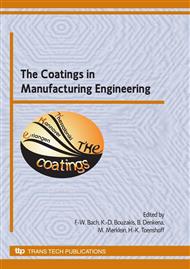[1]
Bargel, H. -J.; Schulze, G.; Werkstoffkunde. 10 Auflage (2008) S. 190-191.
Google Scholar
[2]
Liedke, D.; et. al.; Behandlung von Eisenwerkstoffen 2, 4. Auflage (2007).
Google Scholar
[3]
Linse, D.;: Oberflächenbehandlung mit Lichtbogenplasmabrennern zur Standmengenerhöhung von Gesenkschmiedewerkzeugen, Dissertation: Leibniz Universität Hannover (1993), Fortschrittbericht VDI, Reihe 5: Grund- und Werkstoffe.
Google Scholar
[4]
Haferkamp, H.; et. al.: Einsatz neuer Werkstoffe und Herstellverfahren für Schmiedegesenke. Abschlußbericht Transferbereich 10 (2000).
Google Scholar
[5]
Pöge, M.: Beitrag zum Lichtbogenschweißen von verdeckten T-Stoß- verbindungen. Dissertation Leibniz Universität Hannover (1998).
Google Scholar
[6]
Birkelbach, M. Echte Simultanbestimmung von Stickstoff, Sauerstoff, Wasserstoff in anorganischen Feststoffen mit dem neuen Leco TCH600, GIT Labor-Fachzeitschrift 4/(2002).
Google Scholar
[7]
Ferkel, H.; et. al.: RF plasma nitriding of serverely deformed iron-based alloys, Materials Science and Engineering, A348 (2003) S. 100-110.
DOI: 10.1016/s0921-5093(02)00687-1
Google Scholar
[8]
Cherenda, N.N.; et. al.: Modification of high-speed steels by nitrogen compression plasma flow: Structure, element composition, tribological properties, Surface & Coatings Technologie 200 (2006), S. 5334-5342.
DOI: 10.1016/j.surfcoat.2005.06.007
Google Scholar
[9]
Nürnberger, F,; et. al.: Simulation of the γ-grain size evolution during precision forging of helical gears made of tempering steel 42CrMo4. Wissenschaftliche Nachrichten der Nationalen Technischen Universität der Ukraine (KPI), Nr. 48 (2006).
Google Scholar
[10]
Bach, Fr. -W.; et. al.: Qualification of a Modified Triplex II Plasma Gun for Processing of Liquid Precursors and Wire- or Powder Shaped Spray Materials under Controlled Atmosphere, Conference Proceedings, ITSC (2005).
DOI: 10.31399/asm.cp.itsc2005p1199
Google Scholar
[11]
Vanin, V.S.; Nitriding of Steel by atmospheric nitrogen in arc discharge plasma, Fiziko-Khimicheskaya Materialov, Vol. 6, No. 2, pp.111-112 (1970).
Google Scholar
[12]
Tu, X.; et. al.: Characterization of an atmospheric double arc argon-nitrogen plasma source, Physics of Plasma 15, American Institute of Physics, (2008).
Google Scholar
[13]
Penetante, B.M.; et. al.: Electron-impact dissociation of molecular nitrogen in atmospheric-pressure nonthermal plasma reactors, Appl. Phys. Lett. 67 (21), American Institute of Physics, (1995).
DOI: 10.1063/1.114876
Google Scholar


